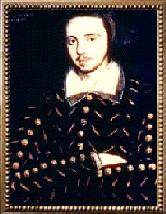|
The Tragical History of
Doctor Faustus
Christopher Marlowe
(1564-1593)
Medieval Plays
The
Morality Play
Elements of The Morality Play in Marlowe”¦s Dr. Faustus
Summary
Themes
Structure
Function of the Comic Scenes
Characterization
Relevant
Links
The
Tragical History of Doctor Faustus
Christopher Marlowe (1564-1593)
English dramatist and poet (Elizabethan)

Major plays (tragedies):
 |
Tamburlaine the Great (c. 1587)
|
 |
Dr. Faustus (c. 1588) |
 |
The Jew of Malta (c. 1589)
|
Marlowe's Dramas
Marlowe's Dr. Faustus
Back to top
Medieval Plays
Mystery ”X
enact events of the Bible, generally part of dramatic cycles presented on
a religious holiday.
Miracle ”X focus on enactments of the
miracles performed by the saints.
Morality ”X focus on allegorical
representations of moral issues, designed to stand alone.
Doctor Faustus borrows many of the conventions of the morality play.
Back to top
The
Morality Play
 Developed in the late Middle Ages.
Developed in the late Middle Ages.
 The
central figure usually represents humanity in general. (Faustus represents
humanity but is also an individual.) The
central figure usually represents humanity in general. (Faustus represents
humanity but is also an individual.)
 A
dramatized allegory in which abstract virtues and vices appear in
personified form, which serve as inspiration for various characters in
Renaissance drama. A
dramatized allegory in which abstract virtues and vices appear in
personified form, which serve as inspiration for various characters in
Renaissance drama.
Back to top
Elements of The Morality Play in Marlowe”¦s Dr. Faustus
 The
battle over the spirit, waged by a Good Angel and a Bad Angel. The
battle over the spirit, waged by a Good Angel and a Bad Angel.
 The
parade of the Seven Deadly Sins: Pride, Covetousness, Envy, Wrath,
Gluttony, Sloth, Lechery. The
parade of the Seven Deadly Sins: Pride, Covetousness, Envy, Wrath,
Gluttony, Sloth, Lechery.
 The
potential for salvation, which exists until Faustus finally succumbs to
despair and gives up all hope of being able to repent. The
potential for salvation, which exists until Faustus finally succumbs to
despair and gives up all hope of being able to repent.
Back to top
Summary
Prologue: Dr. Faustus,
Rhodes, Germany
Scene 1: Faustus dissatisfies with all the knowledge he studies and
determines to study magic.
Scene 3: Calls Mephastophilis, Lucifer”¦s minister
Scene 5: Faustus surrenders his soul to Satan and has great power
among 24 years
Scene 7: Amazes the Pope by becoming invisible
Scene 9: Calls the spirit of Alexander the Great
Scene 11: Brings ripe grapes in January
Scene 12,13: When 24 years is almost over, he begins to fear Satan
and nearly repents. He is carried off by devils at the end.
Back to top
Themes
 Sin,
Redemption and Damnation Sin,
Redemption and Damnation
 Sin: acts
contrary to the will of God Sin: acts
contrary to the will of God
In making a pact with Lucifer, Faustus commits the ultimate sin: not only
does he disobey God, but he consciously and even eagerly renounces
obedience to him, choosing instead to swear allegiance to the devil.
However terrible Faustus”¦s pact with Lucifer may be, the possibility of
redemption is always open to him. All that he needs to do is ask God for
forgiveness. Yet, Faustus decides to remain loyal to hell.
 The
conflict between Medieval and Renaissance Values: The
conflict between Medieval and Renaissance Values:
The medieval world placed God at the center of existence and
shunted aside man and the natural world.
The Renaissance was a movement that began in Italy in the fifteenth
century and soon spread throughout Europe, carrying with it a new emphasis
on the individual, on classical learning, and on scientific inquiry into
the nature of the world.
In the medieval academy, theology was the queen of the sciences.
In the Renaissance, secular matters took center stage.
 Power as a Corrupting Influence
Power as a Corrupting Influence
Gaining absolute power corrupts Faustus by making him mediocre and by
transforming his boundless ambition into a meaningless delight in petty
celebrity.
 The
Divided Nature of Man The
Divided Nature of Man
Internal struggle (personified in
good angel and the evil angel, and the old man)
”@
 Selling
his soul to obtain power Selling
his soul to obtain power
 Drawn up
the character of an intelligent learned man tragically seduced by the lure
of power greater than mortally meant to be Drawn up
the character of an intelligent learned man tragically seduced by the lure
of power greater than mortally meant to be
 The
superstitious mind frequently deemed magicians in league with the devil The
superstitious mind frequently deemed magicians in league with the devil
 Ideal of
humanism: damn nonetheless, thus satirizing the ideals of Renaissance
Humanism Ideal of
humanism: damn nonetheless, thus satirizing the ideals of Renaissance
Humanism
Back to top
Structure
In extant form the play shows the
familiar double-plot construction with buffoonery in the subplot (in
prose) to parallel the Faust theme (the major plot”Xin verse).
The Good and Bad Angels contending
for the soul of Faustus come straight out of the medieval Moralities.
3 main parts:
1. The lure of Faustus
2. Faustus owns the magic power
3. The death of Faustus
Back to top
Function
of the Comic Scenes
Cover passage of time.
Parallel and parody the main plot.
Foreshadow events to come.
Give comic relief.
Back to top
Characterization
Faustus
He is bold enough to sell his soul
to the Devil for ultimate knowledge.
He is sometimes ultimately arrogant, overly confident.
He is a loner who faces the ultimate test by himself.
He can be viewed as naïve.
A contradictory character:
”@
”@
”@
”@
Represents the spirit of the
Renaissance
Minor Characters
Wagner: Faustus”¦s servant, a
student
Valdes and Cornelius: Faustus”¦s friends, magicians
Robin and Rafe: Ostlers at an inn. Even these two fools can learn
enough magic to summon demons.
Emperor Charles V
A knight at the court (Benvolio)
Horse-courser
Back to top
Relevant
Links
http://mchip00.med.nyu.edu/lit-med/lit-med-db/webdocs/webdescrips/marlowe278-des-.html
http://www.infoplease.com/ce6/people/A0831904.html
http://athena.english.vt.edu/%7Ejmooney/renmats/faustus.htm
http://spider.georgetowncollege.edu/english/allen/meddram.htm
”@
”@ |
